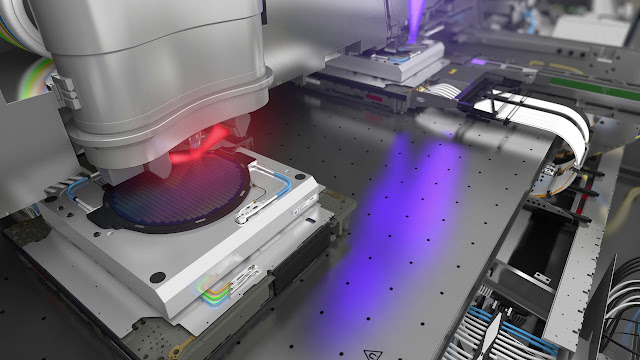Wafer Laser Marking CA offers a range of features that provide users with high accuracy marking. The process is also very energy efficient and requires low maintenance, making it an ideal choice for a wide range of applications. Semiconductor fabrication and packaging represent challenging marking applications, with small marks often required on very thin device geometries. Near IR laser markers are used for this type of work, as they are capable of producing shallow marks without damaging surrounding material.
High Precision
Wafer
Laser Marking CA is a system combining robotic part handling, automated part
alignment, a laser source, beam delivery optics, and control and interface
software. The system performs high-speed silicon wafer etching, marking, and
glass scribing for NGS Flow Cell production.
The
system is configured to accept a predetermined size wafer and automatically
position the wafer relative to the laser marker along a direction substantially
perpendicular to the plane of the wafer. The system may also include a second
positioning subsystem for automatically positioning the wafer relative to the
laser marker along another direction substantially perpendicular to the plane.
The process
500 receives a scribe pattern from an imaging sensor, saves the scribe pattern
in a memory, and performs marking on the back side of the wafer according to
the scribe pattern as recognized by the imaging sensor. The process 500 then
cuts the wafer from the back side based on the scribe pattern as recognized by
the imaging sensors.
Low Energy Consumption
Wafer Laser
marking is a highly important process in the semiconductor
industry because it allows manufacturers to track wafers through the various
stages of the manufacturing process. It also helps prevent damaged and
defective chips from being distributed.
Low
energy consumption is one of the primary benefits of using a laser for marking.
This is because the energy beam is so precise that it can exert just the right
amount of power without dispersion, ensuring that marks are not compromised.
Moreover,
lasers are used to mark materials that cannot be engraved with conventional
marking systems. This is especially the case with sensitive silicon wafers,
which can be damaged if they are cut by a conventional cutting device.
In
addition, lasers can be used to mark a variety of materials, including plastics
and metals. In this way, manufacturers can create high-quality marks that are
easy to read.
Low Maintenance
Unlike
other marking methods like dot-ping, acid etching, and electrophoresis, laser
marking does not damage the substrate. This makes it an ideal solution for
wafer fabs because it ensures wafer traceability.
It
also provides an excellent scalability option for production. It can be
operated with a variety of wafer sizes, including those ranging from 4′′ to
8′′.
Laser
direct part marking (LDPM) is a fast and reliable method of delivering
high-quality, long-lasting code symbologies on any metal, plastic or organic
material. Datalogic has a broad portfolio of laser markers to choose from,
including fiber, CO2, ND:YAG, UV, and green.
Moreover,
laser markers are known for their low maintenance compared to other marking
technologies. They are a non-contact process that allows for minimal mechanical
wear between the marking system and the target material, which helps you reduce
costs and downtime.
Easy to Operate
Wafer Laser
marking silicon is an easy to operate process. It does not use
any chemicals or inks, so it is also much safer for the environment. Another
great feature of laser marking is that it's a lot faster than other methods. In
fact, entire stacks of wafers can be marked in a matter of minutes.
The
laser marking system is extremely accurate, so even the tiniest details are
always precise and consistent. This is why laser marking is one of the best
choices for semiconductor manufacturers.
Laser
marking systems come in a variety of different sizes and styles. Some are
designed for system builders and production line integration while others are
self-contained, table-top systems. They are also ideal for 3D marking,
engraving, and mark serialization.
